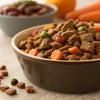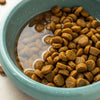How Long Does Unopened Dry Dog Food Last? A Comprehensive Guide for Pet Owners
- Houndsy
Table of Contents
- Introduction
- The Shelf Life of Unopened Dry Dog Food
- How to Store Dry Dog Food for Maximum Freshness
- Signs That Dog Food Has Gone Bad
- Best Practices for Managing Your Dog's Diet
- Conclusion
Introduction
Did you know that approximately 60% of dog owners worry about the freshness of their pet's food? It's a legitimate concern, especially considering that the food we give our furry friends plays a vital role in their overall health and well-being. As loving pet parents, we want to ensure that our dogs are getting the best possible nutrition without compromising on quality. In this blog post, we will explore a question that many of us have asked: how long does unopened dry dog food last?
At Houndsy, we understand that feeding our dogs should be a straightforward and enriching experience, free from worry about food quality and safety. Our mission is to simplify and elevate the dog-feeding experience, and part of that mission involves educating fellow dog owners about proper food storage and longevity. By the end of this article, you will have a thorough understanding of the shelf life of unopened dry dog food, how to store it effectively, and the signs that indicate it may have gone bad.
We'll cover several key topics to guide you through this essential aspect of pet care, including:
- The shelf life of unopened dry dog food
- Factors affecting the longevity of dog food
- Storage tips to maximize freshness
- Signs that dog food has gone bad
- Best practices for managing your dog's diet
So, let’s dive in and ensure that our four-legged companions are always well-fed with safe and nutritious food!
The Shelf Life of Unopened Dry Dog Food
Understanding how long unopened dry dog food lasts is crucial for every pet owner. Generally, unopened bags of dry dog food can last anywhere from 12 to 18 months from the date of manufacture. However, this shelf life can vary based on several factors, such as the type of food, the packaging, and the storage conditions.
Factors Influencing Shelf Life
- Ingredients: Higher-quality dog foods—those with limited preservatives and more natural ingredients—may have a shorter shelf life compared to those with synthetic preservatives. Always check the packaging for information about the food's ingredients and their quality.
- Packaging: The type of packaging used can also affect how long the food stays fresh. Most reputable brands use bags made from food-grade materials designed to keep air and moisture out. The integrity of the packaging is essential in maintaining the food’s freshness.
- Storage Conditions: As we will discuss further, the conditions in which you store the unopened bag of dog food can significantly impact its longevity. Keeping it in a cool, dark place away from direct sunlight is crucial.
To ensure you get the most out of your dog food, always check the "best by" or "use by" date on the bag. This date is determined based on the manufacturer's testing and is a reliable guideline for the product's freshness.
How to Store Dry Dog Food for Maximum Freshness
Now that we have established the shelf life of unopened dry dog food, it’s essential to know how to store it properly to maximize its longevity. Here are some best practices to consider:
1. Keep It in the Original Packaging
While it might be tempting to transfer dog food to a different container, it's usually best to keep it in its original packaging. This packaging is specifically designed to minimize exposure to air and moisture. If you choose to transfer the food, make sure to use an airtight container made from food-grade materials.
2. Store in a Cool, Dry Place
Heat and humidity can cause dry dog food to spoil more quickly. Ideally, you should store the food in a cool, dry place, away from direct sunlight. A pantry or a cupboard that maintains a stable temperature is an excellent option. Avoid places like garages or basements that might have fluctuating temperatures.
3. Minimize Air Exposure
Once the package is opened, air exposure is one of the main factors that can lead to food spoilage. If you’ve opened the bag, be sure to seal it tightly after each use. Using a clip or bag sealer can help keep the food fresh.
4. Monitor the Environment
Regularly check the area where you store your dog food. If you notice any signs of moisture or pests, it may be time to relocate the food to a different space or container.
By following these storage guidelines, you can help ensure that your unopened dry dog food remains fresh and safe for your beloved pet.
Signs That Dog Food Has Gone Bad
Even with proper storage, dog food can eventually go bad, especially if it has been opened. Here are some signs that your dry dog food may no longer be safe for consumption:
1. Unpleasant Odor
One of the most apparent signs that dog food has gone bad is an off or rancid smell. Fresh dog food should have a pleasant aroma. If you detect a strong or unpleasant odor, it's best to discard the food.
2. Visual Changes
Keep an eye out for any discoloration or visible mold. Fresh kibble should be dry and uniform in color. If you notice dark spots, clumping, or any signs of mold, it’s a clear indicator that the food has deteriorated.
3. Change in Texture
If dry dog food has become moist, crumbly, or has an unusual texture, it may have absorbed moisture and is no longer safe for your dog to eat.
4. Reluctance to Eat
If your dog shows signs of hesitation or refusal to eat their food, it may be an indicator that the food has gone bad. Dogs have a keen sense of smell and can often detect spoiled food.
If you suspect that your dog may have consumed spoiled food, watch for any signs of food poisoning such as vomiting, diarrhea, or lethargy. If you notice any of these symptoms, consult your veterinarian promptly.
Best Practices for Managing Your Dog's Diet
To ensure your dog is receiving the best nutrition possible, it’s essential to manage their diet effectively. Here are some tips to help you do just that:
1. Buy in Moderation
If you have a smaller dog or one that doesn’t consume large amounts of food quickly, consider buying smaller bags of kibble. This approach minimizes waste and ensures that your dog is always eating fresh food.
2. Follow Feeding Guidelines
Every dog is unique, and their dietary needs can vary based on factors like age, size, and activity level. Always refer to the feeding guidelines on the dog food packaging and adjust portions as necessary to maintain a healthy weight for your dog.
3. Rotate Food Brands
If your dog has no food allergies or sensitivities, consider rotating different brands or flavors of dog food to provide variety in their diet. This practice can keep mealtime interesting for your pup while ensuring they receive a range of nutrients.
4. Monitor Weight and Health
Regularly weigh your dog and monitor their health. If you notice any unexplained weight gain or loss, it may be time to evaluate their diet and consult your veterinarian for tailored advice.
By implementing these best practices, we can maintain our dogs' health and happiness while fostering a positive feeding experience.
Conclusion
In summary, understanding how long unopened dry dog food lasts is essential for every pet owner committed to providing the best for their furry friends. Unopened dry dog food typically lasts between 12 to 18 months, depending on various factors such as the ingredients, packaging, and storage conditions. To maximize freshness, we should store it in its original packaging in a cool, dry location, and always be mindful of its condition.
If you notice any signs of spoilage, such as unpleasant odors, visual changes, or a reluctance to eat, it’s best to err on the side of caution and discard the food. With proper care and storage, we can ensure that our dogs receive nutritious and safe meals every day.
To elevate your pet feeding experience further, consider exploring our flagship product, the Houndsy Kibble Dispenser. Designed with modern aesthetics and functionality in mind, it makes feeding your dog more convenient and enjoyable.
FAQ
1. How can I tell if my dog food is still good? Look for signs such as unpleasant odors, visual changes, or changes in texture. If your dog is hesitant to eat, it may also be a sign that the food is spoiled.
2. Can I store dry dog food in plastic containers? Yes, you can store dry dog food in plastic containers, but it’s essential to ensure that they are airtight and made from food-grade materials to prevent spoilage.
3. How often should I check my dog food for freshness? It's a good practice to check your dog food every time you feed your pet and ensure it's stored correctly. If you notice any signs of spoilage, discard the food immediately.
4. Does unopened dry dog food really last 18 months? Generally, unopened dry dog food can last up to 18 months, depending on the brand and storage conditions. Always check the "best by" or "use by" date for guidance.
5. What should I do with leftover dog food? If you have leftover dog food after opening, store it in its original packaging or an airtight container in a cool, dry place, and aim to use it within four to six weeks for optimal freshness.












